Growing
12 Common Marijuana Leaf Problems and How to Fix Them
Growing marijuana can be tricky. No matter how much you care about your plants, there’s always the chance that things can go wrong with them. Whether you’re a newbie or an experienced grower, you should always be aware of what’s going on with your growing marijuana. In other words, you need to keep an eye on the plant and especially the leaves to see if something doesn’t look right.
By nature, marijuana is a sensitive plant, from the time the seeds are put into the soil, until harvest time. In this guide, we’ll identify twelve common marijuana leaf problems with solutions for fixing them.
If you’re serious about cannabis growing, you should check out this fantastic growing guide. It helped me to have much healthier plants and to increase yield.
1. Drooping Leaves
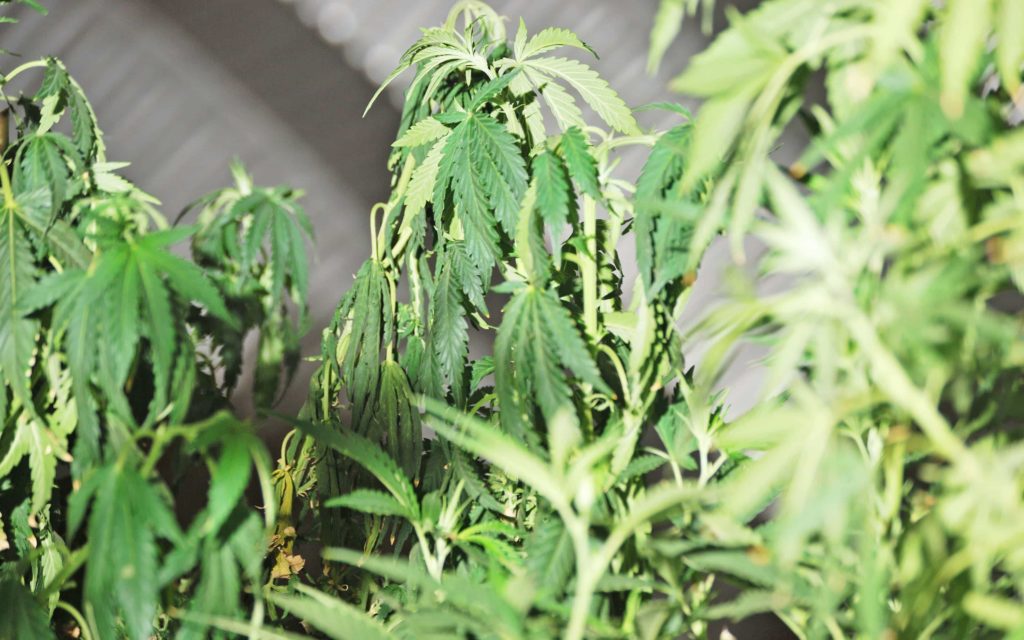

Marijuana leaves that are drooping will feel firm and the entirety of the leaves will appear curled down, including the tips. Drooping pot leaves are most often caused by overwatering. This doesn’t necessarily mean that you’ve been giving the plant too much water. It can also indicate that you’ve been watering too often.
Fix: The best way to fix an overwatered plant with drooping leaves is to give it time between waterings. Then begin to water slowly until the leaves look normal again. Be sure the water can drain out of the bottom of potted plants and pay extra attention to small plants in large containers.
Don’t water your plant until the top of the soil is dry to about an inch deep. Then water the plant until you see about 20% extra water runoff draining out of the bottom of the container. Don’t water your plant again until the top of the soil is dry once again to about an inch deep.
2. Yellow Tips on Leaves
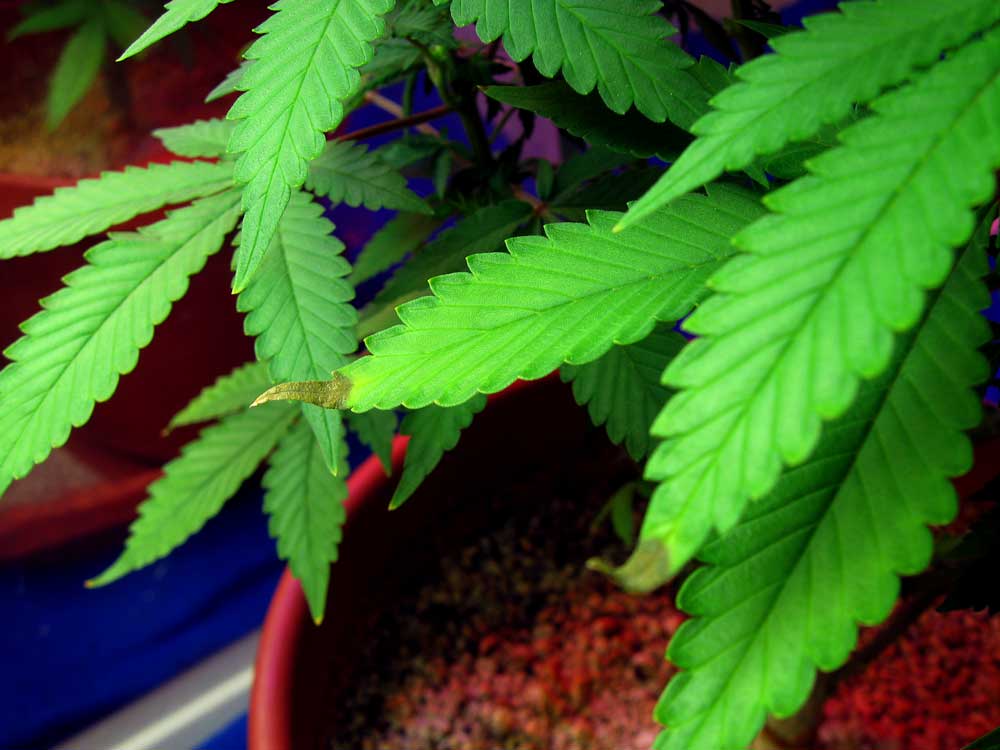

Many first-time growers notice that the leaves of their plants are turning yellow. If you’ve got yellow tips on your leaves, it’s most likely due to a condition called nutrient burn. This happens when you’ve been giving your plant too strong of a nutrient mix, and/or giving it to the plant too often.
Nutrient burn always begins at the very tip of the leaves. As it continues, the leaves will start to turn brown and look crispy, like they’re burned. This is when the growth of your plant will slow down drastically.
If you don’t do anything about the nutrient burn, you’ll begin to lose a lot of leaf mass, which will reduce your overall yields. Even worse, if your plant can’t flush away excess nutrients before harvest time, the buds you harvest may have an unpleasant chemical-like taste.
Fix: To remedy nutrient burn, don’t give your plant any nutrients for a week or two. This allows the plant time to flush out the excessive nutrients. If you’re using a bottled nutrient, make sure it contains a quality set of nutrients that have been specifically designed for marijuana plants. Be sure to follow the manufacturer’s directions and never feed your plant too much.
3. Brown Spots on Leaves


If you start noticing brown spots on your marijuana leaves, it’s a sure sign of calcium deficiency. Your plant needs calcium to provide it with structure and to help protect it against stress like very warm temperatures.
When there’s a calcium deficiency, the upper leaves of the plant tend to show spots first. The lower leaves may curl and twist. The spots are often in a random pattern that can appear copperish, yellowish, or brown.
Fix: The first thing to do when you spot a calcium deficiency in your plant is to check the pH levels of your soil. The optimal range of pH levels to absorb calcium is between 6.2 and 6.5 pH. If your soil isn’t in that range, flush your plant with clean water that’s been altered to have the correct pH range.
After flushing, you should add a nutrient-rich fertilizer or supplement which contains a cocktail of magnesium, iron, and calcium. The reason to include magnesium and iron is that a calcium deficiency often occurs in conjunction with magnesium and iron deficiencies. Cal-Mag supplements are a top choice to add.
4. Yellow Leaves that Start Pointing Up & Curling


If you notice that your leaves are turning yellow at the top of the plant under your grow lights, and they’re pointing or curling up, it’s most likely caused by light burn. Your marijuana plant can only take so much light. If it gets too much light, the leaves will begin yellowing near the source of the light.
Fix: The good news about light burn is that it’s easy to fix and shouldn’t have a lasting effect on your plant. Generally, there are two reasons for the light burn:
- The light source is too close to the top of the plant
- The intensity of the light bulb is too strong for the plant
This means the fix is easy. Move your light up further from the top of your plant. If you can’t do this, reduce the intensity of the light by using a lower intensity bulb.
5. Leaves with a Blue-Green Color or Blotches of Brown
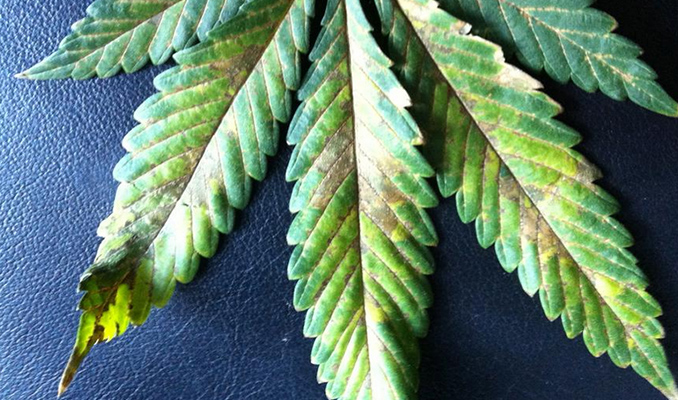

When marijuana leaves turn from green to blue-green or when they have blotches of brown, the plant is typically in need of phosphorus. This essential nutrient helps with root and stem growth and is a vital nutrient during flowering.
The lower and older leaves of the plant are usually affected when phosphorus is lacking. Leaves may also thicken and feel dry or stiff. The leaves may even appear shiny and eventually fall off when a plant is plagued by phosphorus deficiency.
Fix: If your plant is showing signs of a phosphorus deficiency, flush your plant with clean water that contains a regular dose of marijuana-friendly nutrients, including phosphorus. This will flush out any nutrient salts that may be present during the uptake of phosphorus.
Then it’s just a matter of using a fertilizer that can be dissolved in water that has an added amount of phosphorus. Another way to boost the phosphorus level in a plant is to add some nutrients to the soil like:
- Bone or blood meal
- Worm castings or worm tea
- Soft rock phosphate
- Crab shell
- Fish meal
6. White Powdery Mildew on the Leaves


A marijuana plant that has white powdery mildew on the leaves is not only unpleasant to look, at but it also can be cause for concern. Your plant’s leaves have powdery mildew when you see fuzzy, white circular patches on the leaves. Some of the leaves can even look mottled, spotted and wilting.
Fix: The solution to treating powdery mildew is to remove the affected leaves and place them in a plastic bag. The bag will prevent the mildew spores from being released into the air and re-infecting the plant or spreading to nearby plants. Once you’ve carefully removed the affected leaves, treat the stems that held the removed leaves with a fungicide.
7. Yellowing Outside the Veins of the Leaf (with The Veins Remaining Green)
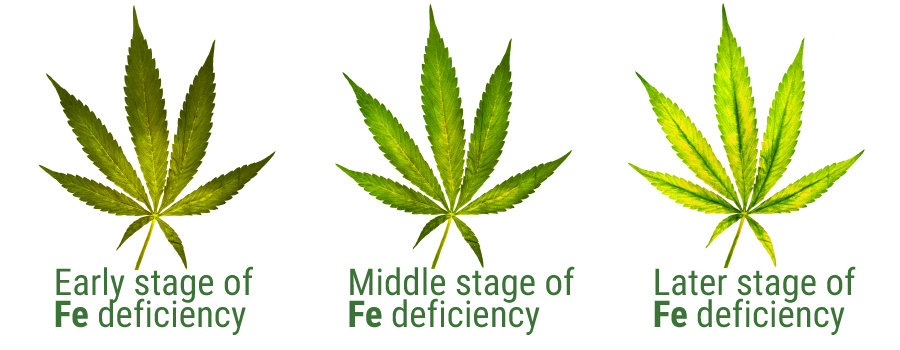

When the leaves of a marijuana plant turn yellow outside of the veins, but the veins remain green, the plant is likely suffering from iron deficiency. In this case, it will slow down the growth of your plant and lead to thin bud development.
When iron deficiency is not treated, the leaves will begin to show signs of burned tips. Eventually, they’ll fall off. That’s why you need to act quickly to save your plant and raise the level of iron it’s getting.
Fix: The first order of business is to let your plant dry out. Then flush the plant with pH balanced water. Then adjust the pH level in the soil. When growing in soil, iron is absorbed best by the root system in the 6.0 to 6.5 pH range. You should then add iron as a supplement to your nutrient feeding schedule.
8. Tiny Flying Insects on Marijuana Leaves


If you’ve been noticing tiny insects buzzing around and landing on your marijuana leaves, chances are you have fungus gnats. Fungus gnats lay eggs in wet soil. Therefore you’ll notice most of these pesky flying bugs around your soil. Even though fungus gnats are tiny, their small size is deceiving.
A single fungus gnat can produce two hundred eggs each week. And since they target the lower parts of your plant that are responsible for water absorption & mineral extraction, they can lead to big problems.
Once the laid eggs are hatched, the larvae come forth and they start feeding on fungi, decaying organic matter, and on your marijuana plant’s roots.
Fix: When it comes to fungus gnats, the sooner you spot them, the faster you can get rid of them. If you discover that you have an invasion, there are a few ways to get rid of them. The first thing to try is to place pieces of yellow sticky trap paper near your plant. The gnats will be attracted to the traps, wherein they stick to them and die.
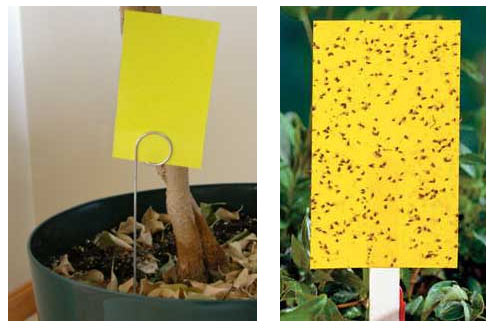

Another remedy is to place a solution of 1-cup of apple cider vinegar, two tablespoons of dishwater, and a tiny bit of tap water near your plant. The gnats will be attracted to the smell of this solution and simply drown.
You can also place about an inch of sand on the topsoil. This will make it impossible for the gnats to get to your soil underneath. Just be sure to add the sand when the soil is dry so you don’t encourage fungal growth between the sand and soil.
9. Lower Leaves Turning Yellow During Vegetative Stage or Early Flowering Phase
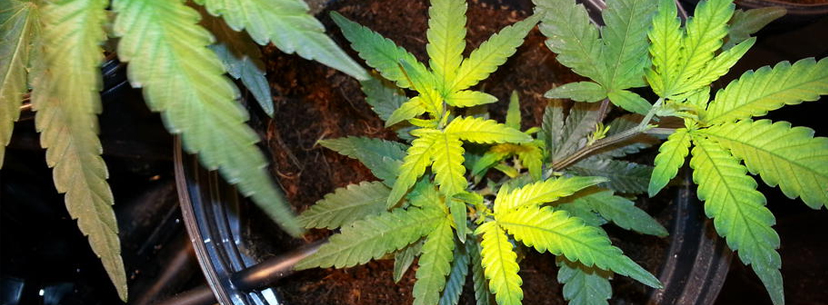

If you notice that the lower leaves of your plant are turning yellow either during the vegetative stage or early in the flowering phase, your plant may be deficient in nitrogen.
A nitrogen deficiency should never be ignored because a marijuana plant’s tissue is made up mostly of nitrogen. If there’s a lack of it, your plant will stop growing, which means you won’t have anything to harvest later on.
It should be noted that it’s common to lose a couple of leaves from the base of your plant now and then. However, if your plant is losing numerous yellow leaves and the yellowing is traveling upward fast, you have to act quickly.
Fix: The best solution to a nitrogen deficiency issue is to use a water-soluble nitrogen fertilizer that will go directly to the roots. Once you add the fertilizer, your nitrogen-deficient plant will absorb the nutrient quickly to return the leaves to a healthy, green color.
10. New Leaves are Small & Thin with Yellowing Between the Veins
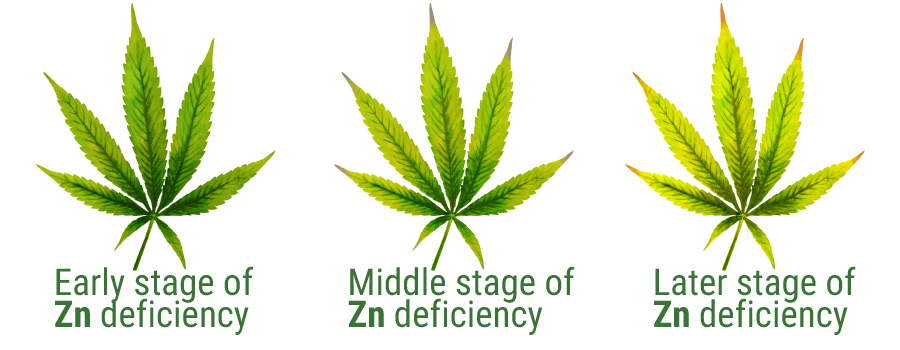

Is your plant developing leaves that are smaller and thinner than what you’re used to seeing? And are those smaller, thinner leaves showing yellow between the veins? Then you probably have a zinc deficiency problem.
Zinc is the nutrient that helps your plant withstand colder temperatures. It also helps break down carbohydrates to sugar. Sometimes a zinc deficiency can be triggered by stressful conditions and can clear up on its own over time. However, to minimize damage, you should react to a zinc deficiency problem as soon as possible, especially if your plant is beginning to flower.
Fix: The best way to fix a zinc deficiency problem is to dry your plant out. Then you should flush the plant with pH-neutral water. The next step involves making sure you’re using water with the correct pH level which is between 6.0 and 6.5 pH. If you’re using heavily filtered water, switch to tap water instead because it has an abundance of zinc.
11. Rusty Areas and Spots on Leaf Edges of the Main Stem
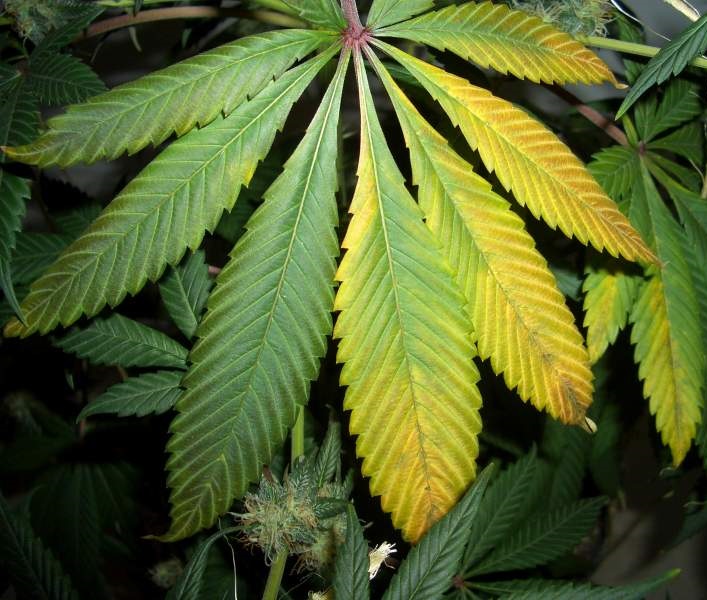

If you notice some rusty areas and spots starting at the ends and along the leaf edges of the main stem, you probably have a potassium deficiency. A lack of potassium can trigger several problems in your plant because this nutrient helps transport water.
Your plant needs potassium at each life stage it goes through. If your plant is consistently lacking potassium, the buds you harvest will be smaller than usual, which is never a good thing. Potassium also helps prevent disease, which very important. In short, potassium is extremely important for the overall well-being of your pot plant.
Fix: An easy way to deal with a potassium deficiency is to use a good fertilizer containing this important nutrient. Other quick fixes include using:
- Potassium bicarbonate
- Liquified kelp
- Potassium sulfate
- Potassium silicate
12. Tips of the Fan Leaves Begin to Curl Upward with a Dry & Withered Look
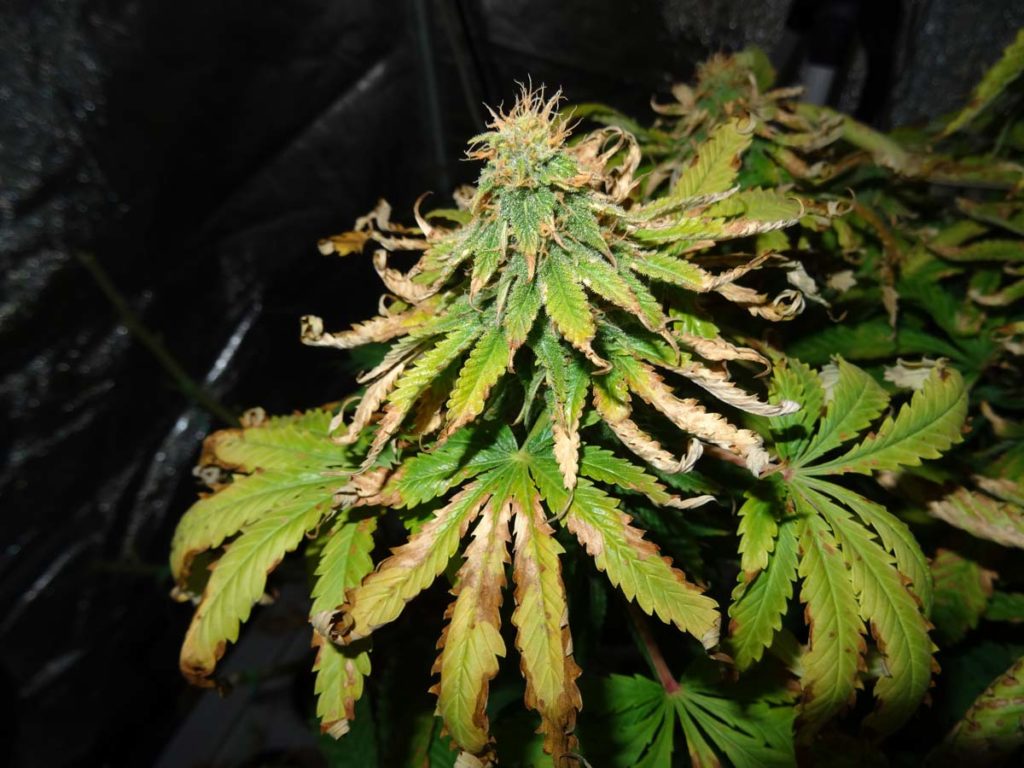

If the large, primary (fan) leaves of your marijuana plant start curling upward and look dry and withered, your plant is probably suffering from heat stress. If left untreated, heat stress can impact both the health of your plant and the success of your harvest.
The optimal temperature range for marijuana plants during the daylight hours is between 70 and 75 degrees Fahrenheit (21-24 degrees Celsius). During the nighttime hours, the optimal range is between 50 and 60 degrees Fahrenheit (10-16 degrees Celsius).
When your marijuana plant experiences excessive heat for a long time, new growth patterns emerge. For instance, you could start seeing new buds on top of the old ones. This happens when the plant is trying to abandon a bud that’s not thriving, due to heat exposure.
Fix: An easy way to deal with heat stress is to adjust the position of your plant. Is it too close to the light? If so, move it. If it’s growing in an area that doesn’t allow the free flow of air around the plant’s base, move the plant so the airflow is better.
You can also add fans to help remedy heat stress. Just a small fan blowing over the top of a plant can help. You can also reduce the heat in the growing area to help your plant recover from heat stress. Maybe all you need to do is turn down the thermostat or crank on the air conditioner!
Conclusion
During the marijuana plant’s journey from seed to mature plant, problems can occur. When you’re able to recognize common marijuana leaf problems and fix them right away, you’ll enjoy the growing experience much more. Just remember that marijuana is a resilient plant. With proper care, it can recover from most problems it encounters to help you harvest great yields.


-



 Strains5 years ago
Strains5 years agoGorilla Glue #4 VS Gorilla Glue #2 – Strain Comparison
-



 Strains5 years ago
Strains5 years agoUGORG #1 Cannabis Strain Review
-



 Strains5 years ago
Strains5 years agoTropic Heat Cannabis Strain Review
-



 Growing5 years ago
Growing5 years agoWeed Measurements Guide: Weights, Quantities, Prices
-



 Strains5 years ago
Strains5 years agoSour Headstash Cannabis Strain Review
-



 Health5 years ago
Health5 years ago7 Proven Health Benefits of Cannabidiol: What is CBD & How Does it Work?
-



 Growing5 years ago
Growing5 years agoSour Diesel BX2 Weed Strain Review
-

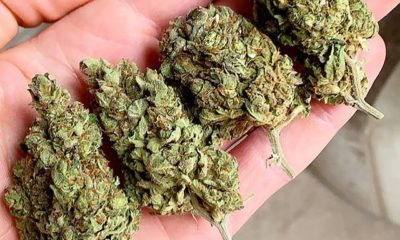

 Strains5 years ago
Strains5 years agoJaffa Berry Strain – Cannabis Strain Review




